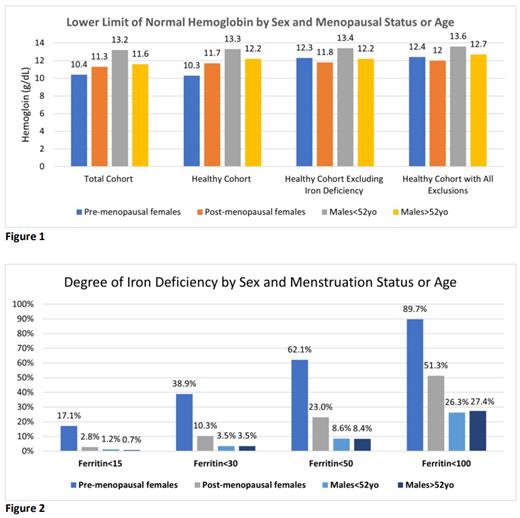Introduction:
Hemoglobin reference intervals (RIs) are developed by laboratory assay manufacturers, and laboratories establish a RI using 120 “normal” samples when first implementing a new assay. Many institutions report different hemoglobin RIs for females and males with wide variation between institutions. Re-evaluation of hemoglobin RIs is warranted to ensure that optimal health for all patients is accurately represented. Using National Health and Nutrition Examination Survey (NHANES) data, we evaluated the impact of excluding adults with chronic disease, iron deficiency (ID), inflammation, and red blood cell (RBC) disorders on hemoglobin lower limit of normal (LLN).
Methods:
Adults > 20 years in the NHANES from 2001-2006 and 2017-2020 were included. Demographic characteristics, self-reported medical history and medication use, and laboratory parameters were extracted. We generated hemoglobin distributions weighted to represent the population of the USA. From these distributions, 2.5%, 50%, and 97.5% values were individually and compositely evaluated when excluding chronic disease (defined as the healthy cohort), ID, inflammation, and RBC disorders. The healthy cohort excluded patients with a medical history of anemia, malignancy, current pregnancy, smoking, or liver, lung, kidney, or heart disease. Iron deficiency was defined as ferritin < 50 ng/mL, transferrin saturation (Tsat)<20%, or total iron binding capacity (TIBC) > 400 μg/dL. Inflammation was defined as ferritin>300 ng/mL, hs-CRP>1 mg/L, albumin<3.5 g/dL, white blood cells>10 K/uL, or TIBC<200 μg/dL. RBC disorders were defined as history of blood transfusion, MCV <80 or >100, Tsat>55%, MCHC >36, Mentzer index<13, or hydroxyurea or iron chelator use. Finally, we conducted several sensitivity analyses that assessed degree of ID at different levels of ferritin ranging from < 15 ng/mL to < 100 ng/mL. All analyses were conducted in R using the survey package.
Results:
There were 10,338 individuals in the total cohort, 5757 in the healthy cohort, and 1609 in the cohort with all exclusions applied. Among females, the hemoglobin LLN was 10.7g/dL in the total cohort, 10.6g/dL in the healthy cohort, 10.4g/dL in the cohort excluding inflammation, 11.7g/dL in the cohort excluding RBC disorders, 12.2g/dL in the cohort excluding ID, and 12.3g/dL in the cohort with all exclusions applied. Among males, the hemoglobin LLN was 12.5g/dL in the total cohort, 12.9g/dL in the healthy cohort, 12.9g/dL in the cohort excluding inflammation, 13.2g/dL in the cohort excluding RBC disorders, 13.0g/dL in the cohort excluding ID, and 13.3g/dL in the cohort with all exclusions applied. The difference between male and female hemoglobin LLN narrowed from 2.3g/dL (12.9g/dL vs 10.6g/dL) in the healthy cohort to 1g/dL (13.3g/dL vs 12.3g/dL) in the cohort with all exclusions applied. For males, the largest difference in hemoglobin LLN was seen when RBC disorders were excluded (12.9g/dL to 13.2g/dL; 0.3g/dL difference), and for females the greatest difference was seen when ID was excluded (10.6g/dL to 12.2g/dL; 1.6g/dL difference). Hemoglobin LLN by menopausal status for females and by age for males is shown in Figure 1. Pre-menopausal females had a significant increase in hemoglobin LLN when ID alone was excluded (10.3g/dL to 12.3g/dL), but this degree of change was not observed in healthy post-menopausal females or males. Degree of ID by ferritin level by sex and menopausal status or age is shown in Figure 2. Using a threshold of ferritin <30 ng/mL, 38.9% of pre-menopausal females were iron deficient compared with 10.3% of post-menopausal females and 3.5% of males.
Discussion:
Applying strict criteria for health and specifically excluding inflammation, RBC disorders, and ID resulted in higher hemoglobin LLN for both sexes and narrowed the difference in LLN between males and females. Pre-menopausal females had the most significant change in hemoglobin LLN from the healthy cohort to the cohort with all exclusions applied, and this was predominately driven by a very high prevalence of ID. ID is a pandemic that disproportionally impacts females of reproductive age. These findings emphasize the burden of ID and its systemic consequences, including normalization of anemia. It is imperative that institutions rigorously and thoughtfully define their hemoglobin RIs by ensuring that strict definitions of health are applied with an emphasis on excluding those with ID.
Disclosures
Merz:X4 Pharmaceuticals: Honoraria; Alexion Pharmaceuticals: Consultancy, Research Funding. Weyand:Spark: Other: Consulting; Pfizer: Research Funding; Novo Nordisk: Other: Consulting, Research Funding; Sanofi: Other: Consulting, Research Funding; Bayer: Other: Consulting; Genentech: Other: Consulting; Takeda: Other: Consulting, Research Funding. Fralick:ProofDx: Consultancy; Signal1: Membership on an entity's Board of Directors or advisory committees. Sholzberg:CSL Behring: Research Funding; Pfizer: Honoraria, Research Funding; Octapharma: Honoraria, Research Funding.


